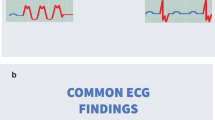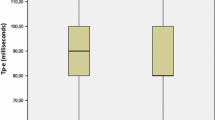Abstract
Arrhythmias have been reported to occur frequently in symptomatic patients with mitral valve prolapse (MVP). The mechanisms causing ventricular arrhythmias in patients with MVP have not been fully investigated. The purpose of this study was to determine the clinical, echocardiographic and heart rate variability parameters, and plasma concentrations of electrolytes and inflammatory markers in predicting ventricular arrhythmias in patients with MVP. A total of 58 consecutive patients with MVP were included in this study. We performed electrocardiography, echocardiography, holter analysis, routine biochemical tests including plasma concentrations of electrolytes and inflammatory markers, and evaluated the clinical characteristics. Ventricular arrhythmia defined as occurrence of any of the followings: ventricular premature contractions (VPCs), VPC couplets, and ventricular tachycardia documented by holter analysis, continuous monitoring or by electrocardiography. Twenty patients (34%) had ventricular arrhythmias, and 38 (66%) patients had no ventricular arrhythmias. Seventeen patients had VPC, 2 patients had VPC couplets and 1 patient had ventricular tachycardia. Univariable predictors of ventricular arrhythmias included isovolumetric relaxation time and the occurrence of moderate to severe mitral regurgitation. Multivariable logistic regression analysis showed that occurrence of moderate to severe mitral regurgitation was the only independent predictor of ventricular arrhythmias (relative risk: 8.42, 95% confidence interval: 1.49–47.64, p = 0.01). Present study showed that the only independent predictor of ventricular arrhythmias in patients with MVP is the occurrence of moderate to severe mitral regurgitation.
Similar content being viewed by others
References
Zuppiroli A, Mori F, Favilli S et al (1994) Arrhythmias in mitral valve prolapse: relation to anterior mitral leaflet thickening, clinical variables, and color Doppler echocardiographic parameters. Am Heart J 128:919–927
Lévy S (1992) Arrhythmias in the mitral valve prolapse syndrome: clinical significance and management. Pacing Clin Electrophysiol 15:1080–1088
Gooch AS, Vicencio F, Maranhao V, Goldberg H (1972) Arrhythmias and left ventricular asynergy in the prolapsing mitral leaflet syndrome. Am J Cardiol 29:611–620
Kligfield P, Levy D, Devereux RB, Savage DD (1987) Arrhythmias and sudden death in mitral valve prolapse. Am Heart J 113:1298–1307
Düren DR, Becker AE, Dunning AJ (1988) Long-term follow-up of idiopathic mitral valve prolapse in 300 patients: a prospective study. J Am Coll Cardiol 11:42–47
Pocock WA, Bosman CK, Chesler E, Barlow JB, Edwards JE (1984) Sudden death in primary mitral valve prolapse. Am Heart J 107:378–382
Diegos-Hasnier S, Copie X, Paziaud O et al (2005) Abnormalities of ventricular repolarization in mitral valve prolapse. Ann Noninvasive Electrocardiol 10:297–304
Boudoulas H, Kolibash AJ, Baker P et al (1989) Mitral valve prolapse and the mitral valve prolapse syndrome: a diagnostic classification and pathogenesis of symptoms. Am Heart J 118:796–812
Coghlan JT (1979) Dysautonomia in mitral valve prolapse. Am J Med 67:236–243
Schiller NB, Shah PM, Crawford M et al (1989) Recommendations for quantitation of the left ventricle by two-dimensional echocardiography: American Society of Echocardiography Committee on Standards, Subcommitte on Quantitation of Two-Dimensional Echocardiograms. J Am Soc Echocardiogr 2:358–367
Levine RA, Stathogiannis E, Newell JB et al (1988) Reconsideration of echocardiographic standards for mitral valve prolapse: lack of association between leaflet displacement isolated to the apical four chamber view and independent echocardiographic evidence of abnormality. J Am Coll Cardiol 11:1010–1019
Nishimura RA, McGoon MD, Shub C, Miller FA Jr, Ilstrup DM, Tajik AJ (1985) Echocardiographically documented mitral-valve prolapse. Long-term follow-up of 237 patients. N Engl J Med 313:1305–1309
Zoghbi WA, Enriquez-Sarano M, Foster E et al (2003) Recommendations for evaluation of the severity of native valvular regurgitation with two-dimensional and Doppler echocardiography. J Am Soc Echocardiogr 16:777–802
Task Force of the European Society of Cardiology and the North American Society of Pacing and Electrophysiology (1996) Heart rate variability: standards of measurement, physiological interpretation and clinical use. Circulation 93:1043–1065
Bazett HC (1920) An analysis of the time-relations of electrocardiogram. Heart 7:353–367
Baedeker W (1988) Mitral valve prolapse syndrome and arrhythmias. Herz 13:318–325
Kramer HM, Kligfield P, Devereux RB, Savage DD, Kramer-Fox R (1984) Arrhythmias in mitral valve prolapse. Effect of selection bias. Arch Intern Med 144:2360–2364
Savage DD, Levy D, Garrison RJ et al (1983) Mitral valve prolapse in the general population. 3. Dysrhythmias: the Framingham Study. Am Heart J 106:582–586
Kligfield P, Hochreiter C, Kramer H et al (1985) Complex arrhythmias in mitral regurgitation with and without mitral valve prolapse: contrast to arrhythmias in mitral valve prolapse without mitral regurgitation. Am J Cardiol 55:1545–1549
Martinez-Rubio A, Schwammenthal Y, Schwammenthal E et al (1997) Patients with valvular heart disease presenting with sustained ventricular tachyarrhythmias or syncope: results of programmed ventricular stimulation and long-term follow-up. Circulation 96:500–508
Negi PC, Kaul U, Dev V, Bahl VK, Bajaj R (1992) Arrhythmias and conduction defects in patients with mitral valve prolapse: a study based on ambulatory monitoring and electrophysiologic studies. J Assoc Physicians India 40:367–370
Picca M, Bisceglia J, Zocca A, Pelosi G (1994) Prevalence and severity of mitral insufficiency and arrhythmia in mitral valve prolapse. G Ital Cardiol 24:1387–1394
Babuty D, Cosnay P, Breuillac JC et al (1994) Ventricular arrhythmia factors in mitral valve prolapse. Pacing Clin Electrophysiol 17:1090–1099
Zouridakis EG, Parthenakis FI, Kochiadakis GE, Kanoupakis EM, Vardas PE (2001) QT dispersion in patients with mitral valve prolapse is related to the echocardiographic degree of the prolapse and mitral leaflet thickness. Europace 3:292–298
Sanfilippo AJ, Abdollah H, Burggraf GW (1989) Quantitation and significance of systolic mitral leaflet displacement in mitral valve prolapse. Am J Cardiol 64:1349–1355
Han L, Ho TF, Yip WC, Chan KY (2000) Heart rate variability of children with mitral valve prolapse. J Electrocardiol 33:219–224
Fauchier L, Babuty D, Cosnay P, Autret ML, Fauchier JP (1997) Heart rate variability in idiopathic dilated cardiomyopathy: characteristics and prognostic value. J Am Coll Cardiol 30:1009–1014
Levy D, Savage D (1987) Prevalence and clinical features of mitral valve prolapse. Am Heart J 113:1281–1289
Puddu PE, Pasternac A, Tubau JF et al (1983) QT interval prolongation and increased plasma catecholamine levels in patients with mitral valve prolapse. Am Heart J 105:422–426
Aviles RJ, Martin DO, Apperson-Hansen C et al (2003) Inflammation as a risk factor for atrial fibrillation. Circulation 108:3006–3010
Di Biase M, Troccoli R, Pellegrino P, Correale M, Brunetti N (2004) Correlation between C-reactive protein and ventricular arrhythmias during the acute phase of myocardial infarction. Ital Heart J 5(Suppl 1):108S–113S
Konstantino Y, Kusniec J, Reshef T et al (2007) Inflammatory biomarkers are not predictive of intermediate-term risk of ventricular tachyarrhythmias in stable CHF patients. Clin Cardiol 30:408–413
Bobkowski W, Siwińska A, Zachwieja J, Mroziński B, Paluszak W, Maciejewski J (2001) Electrolyte abnormalities and ventricular arrhythmias in children with mitral valve prolapse. Pol Merkur Lekarski 11:125–128
Topaloglu S, Aras D, Cagli K et al (2007) Evaluation of left ventricular diastolic functions in patients with frequent premature ventricular contractions from right ventricular outflow tract. Heart Vessels 22:328–334
Author information
Authors and Affiliations
Corresponding author
Rights and permissions
About this article
Cite this article
Turker, Y., Ozaydin, M., Acar, G. et al. Predictors of ventricular arrhythmias in patients with mitral valve prolapse. Int J Cardiovasc Imaging 26, 139–145 (2010). https://doi.org/10.1007/s10554-009-9514-6
Received:
Accepted:
Published:
Issue Date:
DOI: https://doi.org/10.1007/s10554-009-9514-6




